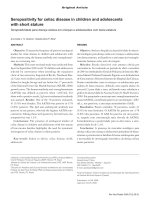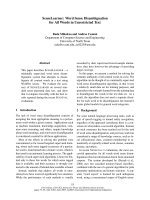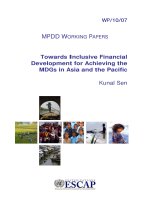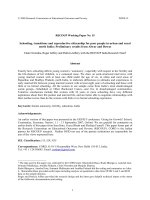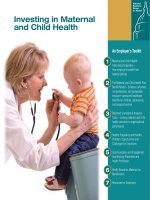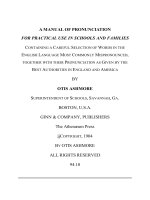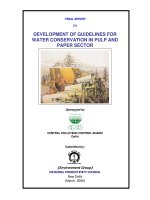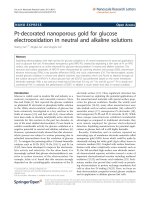Food for all investing in food security in asia and the pacific issues innovations and practices
Bạn đang xem bản rút gọn của tài liệu. Xem và tải ngay bản đầy đủ của tài liệu tại đây (12.68 MB, 370 trang )
About the Asian Development Bank
ADB’s vision is an Asia and Pacific region free of poverty. Its mission is
to help its developing member countries reduce poverty and improve
the quality of life of their people. Despite the region’s many successes, it
remains home to two-thirds of the world’s poor. Nearly 1.7 billion people
in the region live on $2 or less a day. ADB is committed to reducing poverty
through inclusive economic growth, environmentally sustainable growth,
and regional integration.
Based in Manila, ADB is owned by 67 members, including 48 from the
region. Its main instruments for helping its developing member countries
are policy dialogue, loans, equity investments, guarantees, grants, and
technical assistance. In 2007, it approved $10.1 billion in loans, $673
million in grant projects, and technical assistance amounting to
$243 million.
Asian Development Bank
6 ADB Avenue, Mandaluyong City
1550 Metro Manila, Philippines
www.adb.org
Publication Stock No. BKK113029
ISBN 978-92-9092-516-3
Printed on recycled paper
Investing in Food Security in Asia and the Pacific—Issues, Innovations, and Practices
Food security is a critical issue for Asia and the Pacific. The region is the
world’s key supplier and largest consumer of food yet it is also home to
the largest number of the world’s poor and hungry. It presents a stark
contrast—a food bowl that is full to the brim but cannot feed those who
need food the most just to survive. To address food security in a sustainable manner, on 7–9 July 2010, the Asian Development Bank (ADB), Food
and Agriculture Organization of the United Nations (FAO), and International Fund for Agricultural Development (IFAD) joined hands to convene
the Investment Forum for Food Security in Asia and the Pacific at the ADB
headquarters in Manila. This book distills the wealth of information and
depth of discussions derived from the proceedings of this landmark forum.
With this book, ADB seeks to facilitate the sharing of knowledge, innovations, good practices, and lessons on food security and to catalyze greater
interest and action on the issue at every front.
Food for All
About the Book
Food for All
Investing in Food Security in Asia
and the Pacific—Issues, Innovations,
and Practices
Printed in the Philippines
www.ebook3000.com
Food for All
Investing in Food Security
in Asia and the Pacific—
Issues, Innovations, and Practices
© 2016 Asian Development Bank.
All rights reserved. Published 2016.
Printed in the Philippines.
ISBN-10: 92-9092-516-7
ISBN-13: 978-92-9092-516-3
ISBN-10: 92-9092-515-9
ISBN-13: 978-92-9092-515-6
Publication Stock No. BKK113029
Cataloging-In-Publication Data
Food for all: Investing in food security in Asia and the Pacific–issues, innovations, and practices
Mandaluyong City, Philippines: Asian Development Bank, 2016.
1. Food Security.
2. Food.
3. Nutrition.
I. Asian Development Bank.
The views expressed in this publication are those of the contributors and do not necessarily reflect
the views and policies of ADB or its Board of Governors or the governments they represent, or of the
institutions at which the contributors work.
ADB does not guarantee the accuracy of data included in this paper and accepts no responsibility for
any consequences of their use.
By making any designation of or reference to a particular territory or geographic area, or by using
the term “country” in this document, ADB does not intend to make any judgments as to the legal or
other status of any territory or area.
ADB encourages printing or copying information exclusively for personal and noncommercial use
with proper acknowledgment of ADB. Users are restricted from reselling, redistributing, or creating
derivative works for commercial purposes without the express, written consent of ADB.
Note: In this report, “$” refers to US dollars, unless otherwise specified.
6 ADB Avenue, Mandaluyong City
1550 Metro Manila, Philippines
Tel +63 2 632 4444
Fax +63 2 636 2444
www.adb.org
For orders, please contact:
Department of External Relations
Fax +63 2 636 2648
Printed on recycled paper
www.ebook3000.com
“Food security exists when all people
at all times have access to sufficient,
safe, nutritious food to maintain a
healthy and active life.”
– The World Food Summit of 1996
Food for All
Contents
FOREWORD
INTRODUCTION
ABBREVIATIONS
viii
x
xii
CHAPTER 1
A multisector response to food security
1
Message of Haruhiko Kuroda, ADB
Message of Jacques Diouf, FAO
Message of Kanayo Nwanze, IFAD
2
4
5
CHAPTER 2
Food for all through innovative partnerships
A call for a new paradigm
Rt. Hon. James B. Bolger ONZ
CHAPTER 3
Country responses to food security
Bangladesh: Prioritizing agriculture, food security, and nutrition
Muhammad Abdur Razzaque
People’s Republic of China:
Steering development orientation as a driver of change
Zhou Qijiang
India: Exploring out-of-the-box options to feed the poor
T. Nandakumar
Ashok Gulati
Pravesh Sharma
Kavery Ganguly
Lao People’s Democratic Republic:
Targeting a viable and resilient agriculture sector
Phouangparisak Pravongviengkham
Pacific Subregion: Building healthy islands through partnership
Joketani Cokanasiga
Hans Joachim Keil
Aleki Sisifa
iv
www.ebook3000.com
7
8
21
22
37
44
53
60
Contents
CHAPTER 4
Fostering food security through regional cooperation
and integration
The changing role of rice in Asia’s food security
C. Peter Timmer
CHAPTER 5
Investments for enhancing productivity
Harnessing the potential of smallholder farm organizations:
Thailand’s Swift Company
Paichayon Uathaveekul
Spurring rice productivity in Asia:
A global rice science partnership
Robert S. Zeigler
Achim Dobermann
Blending the ancient and the new to provide solutions:
Agricultural water management
Thierry Facon
Aditi Mukherji
CHAPTER 6
Investing in natural resource management
and environment services
Profitable yet sustainable: Conservation agriculture
Yuji Niino
Ecosystem approaches to coastal resources management:
The case for investing in mangrove ecosystems
D. J. Macintosh
M. M. Epps
O. Abrenilla
71
72
95
96
106
117
129
130
140
Securing sustainable livelihoods and environmental protection:
Community forestry as a key strategy
156
Yam Malla
Connecting environment and food security
173
v
Food for All
CHAPTER 7
Building resilience against vulnerability
A panacea? Agricultural insurance
Ake Olofsson
177
178
Picking the “low-hanging fruit” first:
Adapting to climate change
Zhijun Chen
188
Taking a holistic approach:
Transboundary animal disease control
Subhash Morzaria
198
CHAPTER 8
Innovative financing for food security
Innovative solutions show the way:
Lending a helping hand to rural producers
Gilberto M. Llanto
Jocelyn R. Badiola
CHAPTER 9
Investments in connectivity
Solutions from smallholders
How livestock smallholders help out:
Upgrading food security in the Greater Mekong Subregion
T. R. D. Weaver
P. Gautier
209
210
229
230
230
Increasing the market chain participation of small producers:
The NorminVeggies case
239
Joan Cua Uy
Resolving quality control and market access for small farms:
The K-Farm Carambola GAP Program
Kit Chan
Solutions from the corporate sector
Integrating the food supply chain:
The win–win strategy of Field Fresh Foods, India
Raman Ahuja
vi
www.ebook3000.com
247
258
258
Contents
Hello, markets! How the e-Choupal makes connectivity work 266
Shailesh Naik
Harnessing public–private partnerships in Asia:
The UN World Food Programme
Cynthia Jones
The food and nutrition security nexus
CHAPTER 10
Perspectives from key stakeholders
The outlook of development partners
The private sector perspective
The voice of civil society organizations
Investments for Food Security in Asia and the Pacific:
For whom and for what?
CHAPTER 11
Road map for change
279
290
295
296
313
328
337
Summary Remarks of Ursula Schaefer-Preuss, ADB
Summary Remarks of Hiroyuki Konuma, FAO
Summary Remarks of Ganesh Thapa, IFAD
338
340
343
Asia & the Pacific Regional Food Security
Partnership Framework by and among ADB, FAO, and IFAD
345
APPENDIX
Program of the Investment Forum on Food Security
in Asia and the Pacific, 7–9 July 2010
351
vii
Food for All
Foreword
T
he global food and energy price surges in 2007–2008 and again in early
2011 underscore two major challenges to achieving food security in Asia
and the Pacific: frequent food price volatility and the vulnerability of
the region’s food systems. Volatile food markets induce inflation, stymie the
region’s growth, and increase the number of the poor. Vulnerable food systems,
if left unchecked, will reduce the availability, access, and utilization of safe and
nutritious food.
Both challenges are major concerns in the region. Home to the largest number
of the world’s poor, Asia is among the most vulnerable to the impacts of economic
shocks as well as climate change. Sustainable food security is a critical issue for
countries in the region. As both the world’s key supplier and largest consumer of
food, what Asia does for its food security will have significant effects on ensuring
sustainable global food security.
Issues and strategies dealing with food security challenges have been discussed
on a global scale, but there has been no regional dialogue that has focused on
Asia and the Pacific, where food security is imperative, as it affects sustainable and
inclusive growth scenarios crucially.
It is against this backdrop that the Food and Agriculture Organization of the
United Nations (FAO), the International Fund for Agricultural Development
(IFAD), and the Asian Development Bank (ADB) co-organized a regional
investment forum for food security at the ADB headquarters in Manila on
7–9 July 2010.
Bannering the theme “Food for All,” the Investment Forum on Food Security
in Asia and the Pacific was attended by more than 400 participants from 30
countries and focused on the following objectives:
• Scale up and replicate food security investments in Asia and the Pacific.
• Promote and support country-driven food security strategies.
• Promote greater collaboration and partnership among governments,
the private sector, international development agencies, civil society
organizations, and others.
• Share innovations and good practices for rapid replication and expansion.
This book distills the wealth of information and depth of discussions derived
from the proceedings of the landmark forum. With this book, ADB seeks to
provide a better understanding of food security and the opportunities for realizing
it through multisector and partnership approaches. We hope it will facilitate the
sharing of knowledge, innovations, good practices, and lessons on investing in
this field.
viii
www.ebook3000.com
Foreword
We thank FAO and IFAD for painstakingly working with our team from
the Agriculture and Rural Development and Food Security Unit in preparing and
organizing the forum. Our heartfelt thanks also go to the United States Agency for
International Development and The Asia Foundation for sponsoring several of the
participants and meeting some of the forum expenses as well as assisting in some
plenary sessions.
We are grateful to our other development partners, civil society organizations,
and all the presenters, moderators, panelists, and other participants who
contributed to making the forum a success and who have now made this book
possible, including the writers and editors of this book project.
Together with our FAO and IFAD partners, we hope that this book can serve
as a platform for greater advocacy and action in support of the call of the times:
Food for All.
Xianbin Yao
Director General
Regional and Sustainable Development Department
Asian Development Bank
ix
Food for All
Introduction
“F
ood security is a huge challenge. No single entity can address the issue.
You have to connect all the dots. To me, that is the key, because knowledge
dissemination, application on the ground, and faster delivery—all these
will require all stakeholders to come together.”
A participant in the first Asia- and Pacific-wide Investment Forum on Food
Security summed it up well. This book seeks to connect the dots that make up the
issue of food security by providing a compilation of knowledge, good practices,
innovations, and lessons. All drawn from the forum, it weaves these together to
enlarge understanding of the issues involved and to share the rich output of the
forum with a broader audience.
The book presents the highlights of the proceedings of the three-day Investment
Forum (Appendix). Each chapter closely corresponds to a session of the forum
where presentations and interactive discussions took place. Some presentations
have been shortened or condensed due to space considerations.
Introductions to several chapters acknowledge specific entities (e.g., FAO,
IFAD, The Asia Foundation, USAID, ADB units) that were pivotal in organizing
and providing support for particular sessions that parallel the content of
these chapters.
As with the forum sessions, the chapters flow from one into the other.
Taking off from the objectives of the forum, multisector response and innovative
partnerships are key themes addressed in the opening chapters to overcome food
security challenges in the region.
Another key theme links individual country plans under the common goal
of making food security the underlying element of inclusive and sustainable
growth. The forum focused initially on four countries and one subregion that
are representative of the different areas of Asia and the Pacific and have existing
policy, institutional, and strategic frameworks that readily support upscaling of
food security investments in partnership with international organizations (ADB,
FAO, IFAD, etc.), the private sector, and others. These are Bangladesh, the People’s
Republic of China, India, Lao People’s Democratic Republic, and the Pacific
subregion, which are featured in Chapter 3.
Fostering food security through regional cooperation is a clear thread that
runs through the book. This is particularly highlighted in the discussion of
noted development economist C. Peter Timmer about the role of rice in Asian
economies and the collective actions that can be explored to stabilize rice prices as a
“public good.”
x
www.ebook3000.com
Introduction
The range of food security issues is varied and complex and respected scientists,
technical experts, and hands-on managers guide us through the maze with
presentations that not only inform but inspire. The articles spotlight innovations
and good practices—success stories for replication—as well as the necessary areas
for reform and action.
In five succeeding chapters that mirror forum sessions, the book delves into
the following thematic areas:
• enhancing productivity investment, which spans food security research,
information and communication technology, agriculture advisory services,
irrigation and land use, high-yielding technologies, veterinary services,
aquaculture management practices, and post-harvest management;
• upscaling innovations and good practices in natural resource
management, such as forest and coastal resource management, land/soil
management, land use planning, and water resource management;
• increasing investments for resilience, which include risk management,
early warning systems, financing for climate proofing and climate change
adaptation, weather index insurance, food fortification, and nutrition;
• innovative financing for food security through credit, farmer access to
finance, contract farming, and commodity exchange; and
• enhancing connectivity investments for food security through rural
infrastructure, market facilitation and value chain development, fostering
rural small- and medium-sized enterprises and producer organizations,
improving food safety and quality standards, and market information
dissemination.
The participation of civil society organizations from across Asia and the Pacific
enriched the forum’s output to reflect the actual needs and interests of the grassroots
sectors. In a manifesto, they expressed hope and openness to the possibility of
real changes that could happen in the countryside as a result of a more engaged
partnership with development agencies on rural investments.
The forum culminated with the signing of the Asia and the Pacific Regional
Food Security Partnership Framework by the three major organizers—ADB, FAO,
and IFAD. This partnership document is published here in full.
The publication of this book was a collective effort under the supervision of
ADB lead agriculture specialist Lourdes Adriano, with the invaluable editorial
assistance of Fides Lim, Ma. Lourdes Ronquillo, Amelia Esteban, Stephen
Banta, and Jill Gale de Villa, and the logistics support of Rhea Juliano and
Bernadette Agustin.
xi
Food for All
Abbreviations
ADB
AI
APEC
ASEAN
ASEM
AusAID
AWD
B
BRIC
CA
CABI
CBD
CBO
CGIAR
cm
CIP
CRS
CSO
DA
DFID
ECTAD
Ed.
EID
EU
FAO
FAO–RAP
FFS
FMD
FSSLP
FUG
GAIN
GAP
GDP
GDPRD
GEM
GHG
GRiSP
Asian Development Bank
avian influenza
Asia–Pacific Economic Cooperation
Association of Southeast Asian Nations
Asia–Europe Meeting
Australian Agency for International Development
alternate wetting and drying
Thai baht
Brazil, the Russian Federation, India, and China
conservation agriculture
Centre for Agricultural Bioscience International
Convention on Biological Diversity
community-based organization
Consultative Group on International Agricultural Research
centimeter
Country Investment Plan of Bangladesh
Catholic Relief Services
civil service organization
Department of Agriculture
Department for International Development of the United
Kingdom
Emergency Centre for Transboundary Animal Diseases
Editor
emerging infectious diseases
European Union
Food and Agriculture Organization of the United Nations
Food and Agriculture Organization Regional Office for Asia
and the Pacific
Farmer Field School
foot-and-mouth disease
Food Security and Sustainable Livelihood Programme
forest user groups
Global Alliance for Improved Nutrition
Good Agricultural Practices
gross domestic product
Global Donor Platform for Rural Development
Growth with Equity in Mindanao
greenhouse gas
Global Rice Science Partnership
xii
www.ebook3000.com
Abbreviations
GMS
Gt
ha
HPAI
ICM
ICT
IDRC
IFAD
IFC
IFPRI
IFPRI–NDO
ILO
IRRI
IUCN
IWMI
kg
PDR
M&E
MDG
MFF
mt
NFP
NGO
NTFP
OIE
PDSR
PES
PIC
PIF
PPP
PRC
R&D
REDD
RPFS
RSDD
RSOD
SAARC
Greater Mekong Subregion
gigaton
hectare
highly pathogenic avian influenza
integrated coastal management
information and communication technology
International Development Research Centre
International Fund for Agricultural Development
International Finance Corporation
International Food Policy Research Institute
International Food Policy Research Institute–New Delhi Office
International Labour Organization
International Rice Research Institute
International Union for Conservation of Nature
International Water Management Institute
kilogram
People’s Democratic Republic
monitoring and evaluation
Millennium Development Goals
Mangroves for the Future
metric tons
National Food Policy
nongovernment organization
nontimber forest products
World Organisation on Animal Health (formerly Office
International des Epizooties)
participatory disease surveillance and response
Payment for Ecosystem Services
Pacific Island Countries
Pacific Islands Forum
purchasing power parity
People’s Republic of China
research and development
Reducing Emissions from Deforestation and
Forest Degradation
Regional Programmes for Food Security
Regional and Sustainable Development Department (ADB)
RSDD Office of the Director General (ADB)
South Asian Association for Regional Cooperation
xiii
Food for All
SME
SMS
TAD
UK
UN
UNCTAD
UNEP
UNEP–WCMC
UNEP ROAP
UN–REDD
UNICEF
USAID
WFP
WHO
WTO
WVI
WWF
small and medium enterprises
short message service
transboundary animal disease
United Kingdom
United Nations
United Nations Conference on Trade and Development
United Nations Environment Programme
United Nations Environment Programme–World
Conservation Monitoring Centre
United Nations Environment Programme Regional Office
for Asia and the Pacific
United Nations Collaborative Programme on Reducing
Emissions from Deforestation and Forest Degradation in
Developing Countries
United Nations Children’s Fund
United States Agency for International Development
World Food Programme
World Health Organization
World Trade Organization
World Vision International
World Wildlife Fund / World Wide Fund for Nature
xiv
www.ebook3000.com
Chapter 1
A multisector response to food security
Food for all has long been a struggle for a region
that is home to two-thirds of the world’s poorest
and hungriest. The three main conveners of
the first Investment Forum on Food Security
in Asia and the Pacific set out the building
blocks to squarely address this challenge at the
opening ceremonies on 7 July 2010. Their
common framework was the need to boost
investments in the agriculture and food sector
to make this more productive, resilient, and
responsive to the needs of people.
Food for All
Message of Haruhiko Kuroda
President
Asian Development Bank
W
ith a projected gross domestic product growth rate of 7.5% for 2010,
the Asia and Pacific region is rebounding strongly from the recent global
economic, financial, food price, and fuel price crises. The region’s strong
macroeconomic fundamentals, coupled with the emergency fiscal and monetary
stimulus packages enacted by governments over the past 2 years, appear to be
having their intended effect.
In early 2010, a report by the Asian Development Bank (ADB) and the
United Nations noted the region’s remarkable progress in achieving several of
the Millennium Development Goals (MDGs), especially in areas such as poverty
reduction, access to education, and reducing by half the number of people without
access to safe drinking water.
But the report also found that the region’s overall MDG performance continues
to lag in the crucial areas of hunger and food security.
Today, more than a quarter of the region’s children age 5 and younger are
moderately to severely underweight, and more than a third are moderately or
severely stunted. Moreover, 18% of infants have low birth weight.
The region’s vulnerability to hunger and food insecurity was made particularly
apparent during the food crisis of 2007 and 2008. According to Food and
Agriculture Organization data, soaring food prices caused more than 100 million
people to join the ranks of the global hungry last year alone. The effects of this trend
have been felt most acutely here in our region, where two-thirds of the world’s one
billion hungry people now reside.
Contrary to what many people may think, the recent food crisis was not
the result of grain shortages. Instead, it was caused by a complex range of factors
that include protectionist food policies and longstanding neglect on the part of
governments to provide incentives for the private sector to invest in agriculture.
These key areas of policy and investment are the very building blocks on which
we must now focus to ensure that this region’s agriculture sector can become more
productive, resilient, and attuned to the consumer market in the future.
So what needs to be done to put these building blocks in place?
First and foremost, we need to develop an enabling policy and institutional
environment for the private sector to support the development of the food
supply chain.
We need to boost investment in the agriculture and food sector, particularly in
the areas of rural infrastructure. The physical connections between food producers
and consumers who rely on them must be improved.
2
www.ebook3000.com
A multisector response to food security
We must introduce productivity-enhancing measures—such as irrigation and
water resources management—and invest more in research and development.
Most importantly, we need to act collectively, and that is what brings us
here today.
For our part, ADB views food security as one of the underlying components
for sustainable and inclusive economic growth. Earlier this year, ADB approved an
Operational Plan for Food Security in Asia and the Pacific. It calls for a multisector
approach to improve the productivity, connectivity, and resilience of food supply
chains; enhanced partnerships; and increased but focused support for agricultural
research.
ADB has committed $2 billion a year toward this plan, which harnesses our
comparative strength in the infrastructure, environment, regional cooperation,
finance, and education sectors.
We hope that this sum will complement and help galvanize the work of our
development partners, the public and private sectors, and civil society organizations
that are committed to making hunger a problem of the past.
The presence of so many of you here today shows that there exists a collective
determination to tackle food security challenges.
Achieving food security at the regional, national, and household levels has long
been a struggle for the region, even during the best of economic times. Building
on the hard lessons we learned during the 2008 food price crisis, a sustainable and
balanced economic rebound in Asia presents us with a golden opportunity for
harnessing our collective resources to achieve food security.
It is high time to move out of our comfort zones and forge new partnerships,
collaborative arrangements, and networks with the single objective of achieving
Food for All. We hope that at the end of the forum we will have committed
to concrete steps for building food security alliances at the country and
regional levels.
3
Food for All
Message of Jacques Diouf
Director-General
Food and Agriculture Organization of the United Nations
D
uring the past 3 years, hunger has dramatically increased in the world on
account of soaring food prices and the global financial and economic crisis.
In 2009, there were 1 billion hungry people in the world, an increase of about
100 million over the previous year. In the Asia and Pacific region alone, the number
of undernourished people increased by over 60 million in 2009 to 642 million.
The sheer magnitude of food insecurity is the result of the low priority that
has been given to agriculture in economic development policies, as shown, for
example, by the drop in the share of agriculture in official development assistance,
from 19% in 1980 to about 5% today.
The Food and Agriculture Organization of the United Nations (FAO) estimates
that food production must rise by 70% in the world by 2050.
In the Asia and Pacific region, agriculture accounts for 11% of the gross
domestic product of its developing countries and over 50% of total employment.
In view of the critical dependence of this region’s people on agriculture for their
food security, it is encouraging to note that the long-standing neglect of agriculture
is finally being reversed.
Through the Food Security Initiative, the Group of Eight (G8) committed in
2009 in L’Aquila, Italy to mobilize $20 billion over 3 years for food security and
agriculture. In Toronto, in June 2010, the G8 kept the same commitment. This is a
step in the right direction, provided that it is implemented effectively and rapidly.
To assist the efforts of member countries to achieve the World Food Summit
and Millennium Development Goal targets on hunger reduction, FAO has assisted
several countries and regional economic organizations in the Asia and Pacific
region in the design of their national and regional programs for food security.
FAO also launched, in December 2007, the Initiative on Soaring Food Prices to
facilitate access by small farmers to indispensable inputs. In Asia and the Pacific,
agricultural inputs worth $8 million have been provided to over 140,000 small
farm households in 24 countries. In addition, through the European Union Food
Facility program, FAO has made available $100 million to the Asia and Pacific
region to benefit a quarter of a million households.
The Investment Forum on Food Security in Asia and the Pacific, sponsored by
the Asian Development Bank, FAO, and the International Fund for Agricultural
Development, has a vital role to play. I am particularly pleased that it has been
agreed to open the forum to nongovernment and intergovernmental organizations,
representatives of civil society, the private sector, research institutions, other
international financial institutions, and other United Nations agencies.
4
www.ebook3000.com
A multisector response to food security
Message of Kanayo Nwanze
President
International Fund for Agricultural Development
Enabling poor rural people
to overcome poverty
T
he food price crisis of 2007 and 2008 is still fresh in our memories. It caused
widespread food shortages and food and nutrition insecurity, particularly
among poor children, women, and men.
As home to the largest number of poor and undernourished people in the
world, the Asia and Pacific region was at the epicenter of the crisis and was hit
extremely hard.
Although food prices have eased since then, they are still higher than pre-2007
levels. More importantly, recent studies indicate that food prices will remain high
and volatile in the future.
Although challenges related to food security have been discussed at several
global forums, the focus has generally been on making political commitments to
address food security issues. What is different about this forum is that it provides a
unique opportunity to focus on increased investments to strengthen food security
in Asia and the Pacific.
Long-term growth in agricultural productivity is imperative for food security.
Productivity growth expands supplies, reduces prices, and raises the incomes of
smallholder farmers.
At the same time, productivity growth ensures affordable and adequate food
for poor women and men and disadvantaged groups.
We know that there is significant potential to raise agricultural productivity and
food production in the region. This can be done by improving crop management,
expanding the use of modern varieties, strengthening rural infrastructure,
and improving postharvest technologies. Adequate funding for research and
development must also be provided.
Support must be extended to enable smallholders to expand their production
and gain greater access to markets. We must promote agricultural research that
focuses on their needs, because many of them farm in agroecologically fragile
regions. We must boost their access to agricultural services, including extension
and financial services. We must secure their access to natural resources such as land
and water. And we must enable them to diversify their sources of income.
We must also help them to strengthen their livelihoods in the face of greater
climatic uncertainty. And we must build their awareness of the benefits to be gained
from new approaches to managing weather and other risks.
Although the challenges are many, the region also stands to gain from a
range of promising opportunities. Dynamic private sector investments are leading
5
Food for All
the development of new agrifood industries and market openings that provide
important linkages between small producers and markets.
There is also a high level of political commitment among national governments
to making long-term investments in agriculture. In many countries of the region,
public investment in agriculture has increased in recent years, and bilateral and
regional trade has expanded.
This forum is an important venue for sharing innovations and good practices on
new approaches to sustainable and inclusive food security. It will provide a unique
opportunity for governments, private sector actors, civil society representatives,
and development partners to work together and discuss concrete investment plans
for several countries of the region.
I hope that specific action plans for investment in enhancing food security
through higher production and productivity will be the result.
The International Fund for Agricultural Development (IFAD) is happy to
have the opportunity to collaborate with the Asian Development Bank and the
Food and Agriculture Organization of the United Nations in co-organizing this
important regional event. We are also developing a regional partnership framework
among the three organizations to support countries through coordinated food
security engagements that take into account their specific priorities and constraints.
I hope that other development partners will also join this initiative.
6
www.ebook3000.com
Chapter 2
Food for all through innovative partnerships
James Bolger weaves in the themes of
partnerships and challenges in his keynote
address at the Investment Forum on Food
Security in Asia and the Pacific on 7 July
2010. He notes that we will be able to feed the
world only when we face head-on the bigger
issues that should be kept at the forefront of
any debate on alleviating hunger. He urges, “It
is now a time for new thinking, as yesterday’s
thinking will not solve tomorrow’s problems.”
Food for All
A call for a new paradigm
Rt. Hon. James B. Bolger ONZ
Chairperson, International Advisory Board
of the World Agricultural Forum
Prime Minister of New Zealand, 1990–1997
Making minor adjustments will not feed tomorrow’s world;
to have food for all will require radical rethinking on how
the world moves forward.
G
ood morning and greetings to all.
E nga rangatira, nga kaumatua, nga kuia, nga waka me tehau kainga, tena
koutou, tena koutou katoa.
To the many chiefs, elders, women, the waka, and the home people, my
greetings. The literal meaning of the Maori word for leader, rangatira, is “to weave
people together.” That, I am sure, is the ambition of this gathering.
I want to thank the organizers for their invitation to join you today. I
was invited as the Chairman of the International Advisory Board of the World
Agricultural Forum (WAF). Based in St. Louis, USA, WAF, as a nonpartisan
organization, seeks to engage with all who play a part in the global food chain,
from landless peasant farmers to global corporations.
Through hosting conferences large and small, we seek to stimulate debate
on all aspects of food production, including the wise use of land and water, the
role of science, distribution networks, government policies, and specifically trade
policies that impact on the production and distribution of food. WAF’s most
recent conference was held a few weeks ago in Brasilia and focused on the role that
South America can and must play if we are able to feed a world of 9 billion people
in 2050.
As for me, in addition to everything else, I have been a farmer all my life,
someone who actually produces food and has lived through the vagaries of
Mother Nature, changing economic paradigms, open and closed markets, and
trade distortions to protect the favored, to mention but a few of the issues with
which farmers and those who provide the necessary infrastructure to support them
must work.
To state the obvious, to meet the food needs of people everywhere, we must
include in the partnership and planning not only those who spend their lives in
treasury departments, academia, or policy groups, but also those whose hands are
8
www.ebook3000.com
Food for all through innovative partnerships
battered by hard work and whose faces are weathered by a life in the outdoors,
actually producing food.
I take this early opportunity to acknowledge the outstanding leaders who
will be making presentations; I know that they will not only stimulate debate but
energize the passion required to develop a better framework to meet the needs of
people everywhere.
Time for new thinking
The theme of my remarks this morning is that it is now a time for new thinking, as
yesterday’s thinking will not solve tomorrow’s problems.
In September 2000, almost 10 years ago, the United Nations (UN) Millennium
Conference in New York attracted the largest group of world leaders in history.
They gathered at a time of optimism: the Cold War was over, the world economy
appeared strong, and the terrorist attacks of 9/11 were still a year away. And so,
motivated by good intentions, they signed on to the goal of halving world poverty
by 2015, now only a short 5 years away.
The good news is that, with the work of many, including those organizations
represented here, millions have been lifted out of poverty, and we should celebrate
that success. Unfortunately, with population growth, the bad news is, as the
Executive Director of the UN World Food Programme said a little while back,
“hunger is on the march.” Two hundred million more have joined the ranks of the
hungry in the last few years.
And now, unlike in 2000, there is limited confidence in the construct of the
world economy. The financial crash of 2007–2008 exposed its fragility, and this has
shattered confidence in the prevailing economic model.
Commentators are divided on whether there should be more stimulus or
greater fiscal austerity. The debate reminds me of a saying of that unique American,
Woody Allen: “More than at any other time in history, mankind faces a crossroad.
One path leads to utter despair, the other to total extinction. Let us pray we have
the wisdom to choose correctly.”
I pray that we have the wisdom to choose a different path altogether.
In that context, while the world is open in its admiration of the success of
many economies in the dynamic Asia and Pacific region, we cannot move forward
in isolation, as the problems we face are global, and there is still much to be done
in our region.
We all know that the great challenge of our time is how we will meet the needs
of the projected 9 billion people in 2050 when we are not meeting the basic needs
of only 6.5 billion today.
There are no easy answers on how the world will meet this challenge, for, if
there were, a billion plus people would not be hungry today.
The late Archbishop of Olinda and Recife in Brazil, Dom Helder Camara,
who was an activist for the poor, once observed that “when I give food to the poor,
9
Food for All
they call me a saint, but when I ask why the poor have no food, they call me a
Communist.” While I absolutely agree that it is essential to provide food to the
hungry, we will feed the world only if we answer the bigger question, “Why do the
poor have no food?” We must insist that policy makers keep that question in the
forefront of any debate on alleviating hunger.
My suggested topic is “Food for All Through Innovative Partnerships.”
Partnerships imply working together, contrary to the approach favored by most
economic theorists in recent times, which has emphasized individuals and
firms acting in their own self-interest rather than in the interest of the broader
community.
“Food for All” is so easy to say, but is the world really working through
economic and trade policy to achieve that goal, or is it just something that people
in authority feel they should say and then move on? But move on to what? In
reality, there is nowhere to hide; the old concept of absolute national sovereignty
no longer exists, as each new international agreement redefines sovereignty and
creates a new interdependence, which became very evident in the global meltdown
and now in the uncertain recovery.
From my perspective, to succeed, the world must construct a new paradigm
that discards the concept of a globalization driven by a few big players and instead
moves to recognize the needs of an integrated world community. Within the
paradigm, the most important partnership is that between public policy and the
needs of the people.
To put it into context, let me take you back for a moment to the political debate
following the 2007–2008 crash and the introduction of massive stimulus packages
everywhere to prevent the total destruction of the current economic model. The
message went out in country after country that they must spend—remarkable
advice, given that both citizens and governments were in general overburdened by
debt; but the economic masters could think of no other approach, so the message
was “spend, spend.” There must be a better way.
Let me suggest a different approach, a bold new partnership that focuses on
bringing the 3 billion citizens worldwide who currently live on less than $2.50 a
day into the world economy and so would create a huge new market for goods and
services.
Such an approach would achieve two major objectives—lift hundreds of
millions out of poverty, and create a new engine for sustainable growth in the
world economy—sustainable in that over time it would move consumption from
those who are already consuming too much of Mother Earth’s resources to those
who need to consume more to achieve dignity in life.
Essential partnership with water and land
The next essential partnership if we are to achieve food for all is that among water,
land, science, finance, and people. I will say a little about all five.
10
www.ebook3000.com
